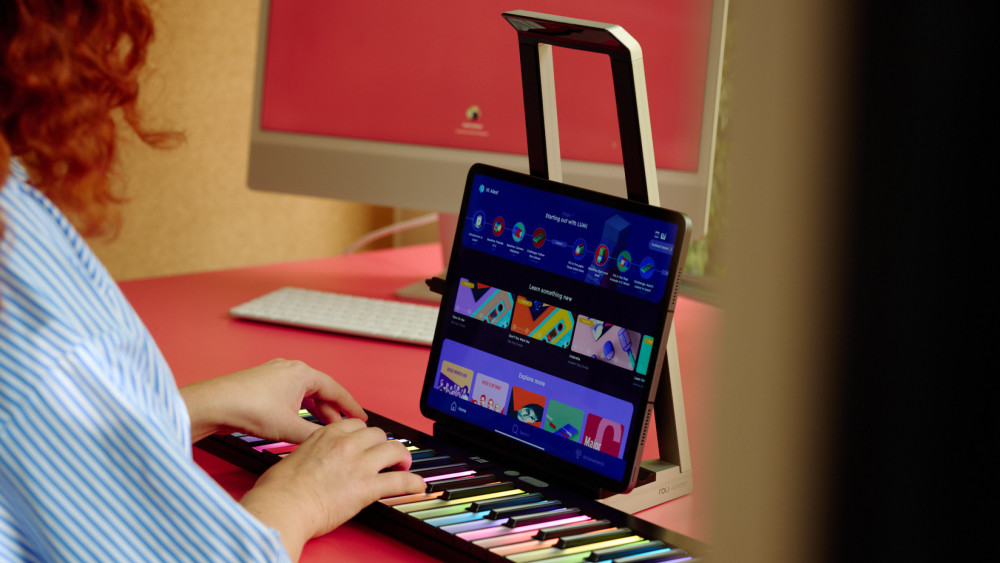Piano progress in five dimensions
How Airwave and Piano M teach you the essential mechanics of playing piano
Piano progress in five dimensions
Airwave and Piano M offer a fun, effective alternative to traditional piano lessons. But why hasn’t learning to play always been fun? Why does the thought of learning to play — something that ought to be a joyful experience — conjure up ideas of strict teachers, rigid practice schedules, and endless scale repetition?
The answer, in part, is that learning piano is necessarily somewhat complex. There’s a lot to take in, and a lot of little details to get right. Playing the right notes is one thing, but playing them the correct way will allow you to progress faster and further — and even have more fun in the process.
Previously, the only way to be sure you were doing everything correctly was to work with a dedicated piano teacher. ROLI Airwave isn’t designed to replace piano teachers. But a number of them were deeply involved in its creation, allowing you to benefit from hundreds of years of accumulated knowledge about form and technique. Their know-how, combined with our breakthrough technology, means you can practice with full confidence, knowing that Airwave is keeping an eye on your progress.
So how does it work? Together with ROLI Piano M and the ROLI Learn app, Airwave enables feedback on five key areas of piano technique. The first two, Harmonic and Rhythmic can be considered the essential foundations for the other three, and it’s your scores in these areas that ROLI Learn uses to determine whether or not you’re ready to progress. Postural, Positional, and Dynamic scores can be considered helpful advice — you may choose to go back and improve them, but low scores won’t prevent you from moving on.
Let’s take a look at each of the five principles in turn.

Harmonic: Are you playing the right notes, in the right order?
This is perhaps the easiest dimension of technique to understand. It’s about playing the correct notes, as shown on your screen. Getting this right is the most fundamental building block towards playing along with your favorite song — and you may be surprised by just how quickly you can reach this milestone.
If you’ve played rhythm-based video games you’ll likely have come across a similar concept. Much like those games, the ROLI Learn app will provide you with a score that reflects your accuracy, but will also give you tips on how to improve next time.
In the ROLI Learn app, this is currently known as Note Accuracy.
Rhythmic: Are you playing on the beat?
The rhythmic dimension of piano technique follows on logically from the harmonic one. Now that you’ve learned which notes to play, are you playing them in time? That is, both at the right tempo and on the beat?
A helpful hint: the “right” tempo is the one that feels right for you. The ROLI Learn app will soon be able to slow down or speed up songs to help you learn more effectively. Finding a particular passage difficult? Slow it down, work through it note by note, and gradually speed things up until you’re playing it with ease.
In ROLI Learn, this is currently known as Rhythm accuracy.

Postural: How are your hands and wrists positioned?
We normally think of posture as the way we stand, the distinctive way in which we hold our bodies upright. But it can also refer to individual parts of our bodies — in this case our hands and wrists. When it comes to playing piano, keeping your wrists too high or low, or your fingers too bent makes it harder to play and can lead to bad playing habits or even injury.
Airwave tracks all of the joints in your hands as you play. It’s incredibly precise, allowing the ROLI Learn app to understand your hand and wrist posture and make suggestions for how you can improve. That way, you won’t need to wonder, “How’s my technique?” You’ll know.
Positional: Which fingers are you using to play each note?
When playing piano, have you ever stopped to think about which finger should play which note? It’s not always immediately obvious, especially when we consider more difficult two handed parts. What happens when your right pinky is holding down a key and you need to play a higher note? What if your hands need to cross over?
With Piano M and Airwave, however, you’ll be given suggestions for exactly which finger to use at any given moment, and provided a score based on how closely your playing matched this guidance. It may seem tricky in the beginning, but following the finger guidance for each note makes subsequent notes easier to play. Mastering this skill early will make the rest of your learning journey both easier and more enjoyable.
Dynamic: How loud do you play each note?
A lot of musical expression is in the volume of notes — from moment to moment and from one song to another. Consider the difference between Liszt’s Consolation No. 3 and Verdi’s Aida: Triumphant March, for example. Or imagine how Wolfgang Amadeus Mozart’s Sonata, No. 16 would sound if every note was played at the same volume.
The volume of a note on a piano depends on the speed with which a key is pressed — faster for a louder note, slower for a softer note. Piano M’s sensors measure the velocity of each key and translate this to note volume.
Airwave is available to preorder now. You can also save big on a range of time-limited bundles, including with Piano M or two Piano Ms for two-handed playing. But be quick, the first shipments of Airwave are available in strictly limited quantities.
Join the ROLI community